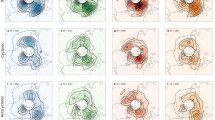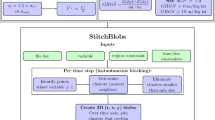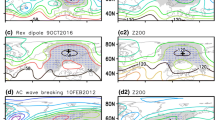Summary
Two different blocking indices are computed for the Southern Hemisphere for the period 1979–1985, one is based on sea level pressure and the other on upper tropospheric zonal wind. The Southern Hemisphere blocking climatology based on these two indices separately presents very similar results, mainly in identifying the region of maximum occurrence over eastern Australia and the western Pacific. The sea level presure index shows strong orographic influences, while the 250hPa zonal wind index is not affected by orography but does exaggerate seasonal variations. It is apparent that blocking occurrence in the eastern Australia and neighbouring areas has a link with climatological atmospheric features.
Similar content being viewed by others
References
Berggren, R., Bolin, B., Rossby, C. G., 1949: An aerological study of zonal motion, its perturbation and break-down.Tellus,1, 14–37.
Dole, R. M., 1983: Persistent anomalies of the extratropical northern hemnisphere wintertime circulation. In:Largescale Dynamical Processes in the Atmosphere (B. J. Hoskins and R. P. Pearce, eds.). London: Academic Press Inc., 85–108.
Elliott, R. D., Smith, B. A., 1949: Study of the effect of large blocking highs on the genral circulation in the northern hemisphere westerlies.J. Meteor.,6, 67–85.
Lejenäs, H., Okland, H., 1983: Characteristics of northern hemisphere blocking as determined from a long time series of observational data.Tellus,35 A, 350–362.
Lejenäs, H., 1984: Characteristics of southern hemisphere blocking as determined from a long time series of observational data.Quart. J. Roy. Meteor. Soc.,100, 967–979.
Mo, K. C., 1983: Persistent anomalies of the Southern Hemispheric circulation. Proceedings of the First International Conference on Southern Hemisphere Meteorology, São José dos Campos, SP, Brazil, August 1983, Amer. Meteor. Soc., 70–72.
Mullen, S. L., 1986: The local balances of vorticity and heat for blocking anticyclones in a spectral general circulation model.J. Atmos. Sci.,43, 1406–1441.
Rasmusson, E. M., Wallace, J. M. 1983: Meteorological aspects of the El Niño/Southern Oscillation.Science,222, 1195–1202.
Rex, D. F., 1950: Blocking action in the middle troposphere and its effect upon regional climate II. The climatology of blocking action.Tellus,2, 275–301.
Shukla, J., Mo, K. C., 1983: Seasonal and geographical variation of blocking.Mon. Wea. Rev.,111, 388–402.
Trenberth, K. E., Swanson, G. S., 1983: Blocking and persistent anomalies in the Southern Hemisphere. Proceeding of the First International Conference on Southern Hemisphere Meteorology, São José dos Campos, SP, Brazil, August 1983, Amer. Meteor. Soc., 73–76.
Van Loon, H., 1956: Blocking action in the southern hemisphere, Part I.Notos,5, 171–177.
Author information
Authors and Affiliations
Additional information
With 8 Figures
Rights and permissions
About this article
Cite this article
Kayano, M.T., Kousky, V.E. Southern Hemisphere blocking: A comparison between two indices. Meteorl. Atmos. Phys. 42, 165–170 (1990). https://doi.org/10.1007/BF01314822
Received:
Revised:
Issue Date:
DOI: https://doi.org/10.1007/BF01314822




